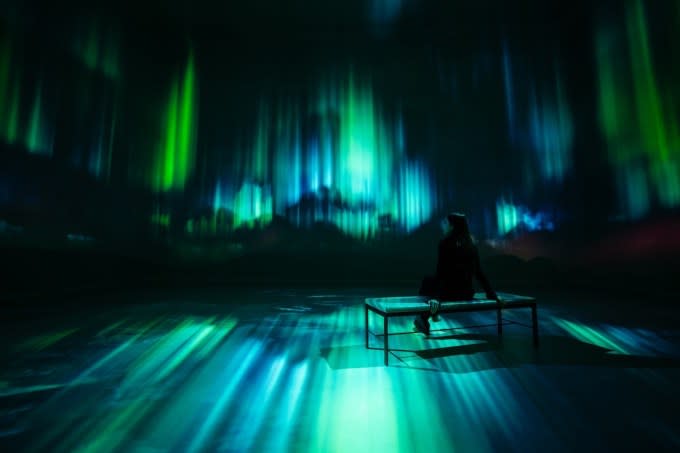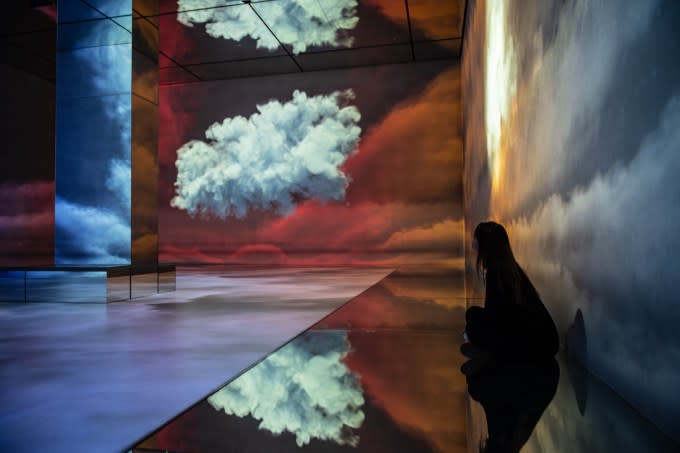This is your brain on Pink Floyd
The human brain has long been a subject of fascination for art and science, which are now both mixed into "Brainstorms: A Great Gig in the Sky," a new live interactive experience to the tune of Pink Floyd.
Interactivity is optional, but memorable. Exhibition visitors can opt in (and pay extra) to have their brain activity recorded while listening to Pink Floyd's classic album "The Dark Side of the Moon" — and later on, displayed as a mesmerizing cloud synced to that same soundtrack in a very large room of London's immersive art gallery Frameless.
Immersive art venues have been popping up across the world, often featuring popular painters whose works blend walls, ceilings and floors around the visitors. But combining the concept with music and a live element brings "Brainstorms" closer to "ABBA Voyage," for instance.
That's not their only thing in common: Both shows similarly use technology as an enabler, not a focus.
This makes "Brainstorms" different from last year's groundbreaking experiment in which neuroscientists were able to re-create Pink Floyd's "Another Brick in the Wall, Part 1" using AI to decipher the brain's electrical activity. This time, it is a spectacle.

While advanced technology is involved behind the scenes, from Emotiv EEG headsets and spatial audio to Unreal-powered visualizations, the starting point of the Brainstorms project was very much music — more precisely, that of late Pink Floyd keyboardist Richard Wright.
Wright's daughter, Gala, wanted to do something special for the 50th anniversary of the album featuring "The Great Gig in the Sky," the iconic tune composed by her father, with no less memorable vocal composition by Clare Torry. "So we started to put together ideas," composer and music technologist JJ Wiesler told TechCrunch during the premiere.
Wiesler is the co-founder of Pollen Music Group, a San Francisco-based creative outlet renowned for its music scores and sound design. With both a music studio and a lab where it works with VR/XR headsets, phones, home devices and more, Pollen isn't new to experimenting. But "this is a bit of a change to take it into the exhibition world," he said.
It was Gala Wright who had the idea to focus on neuroscience and the study of the human brain's reaction to music. This led her and Pollen to partner with Dolby to record the brain activity of 125 volunteers listening to "The Great Gig in the Sky," synced with ad hoc software, Wiesler said.
Conducted last year, the experiment forms the basis of "Aurora," a creation in which the moon casts a glow over the arctic tundra, progressing into an aurora borealis.
"Aurora" takes up the entirety of Frameless's largest gallery, but there are four in total, which wasn't part of the original plan. With 30,000 square feet at its disposal, the Brainstorms team came up with more than fillers. Keeping "great gigs in the sky" as its overarching theme, it took on a room of its own with "Eclipse" and enlisted London-based music artist Imogen Heap for a bird-inspired room.
Get off my cloud
A musician known for engaging with technology, Heap is doubly featured in "Murmur," which is set to her ambient track Cumulus, while two starling flocks — murmurations — represent her brain activity and her daughter dancing in the sunset.

Perhaps more clearly than in any other room, this visualization gives us a glimpse of how the same music can affect different people. That's the science part of Brainstorms: During the visit, participants will learn that visualizations reflect what others felt while listening to Pink Floyd.
In "Aurora," engagement triggers red aurora hues, relaxation adds "a calming blue," and excitement enlivens the movement of the aurora, exhibition panels explain. Meanwhile, in "Eclipse," raw electrical power from the brain fuels solar activity, driving flares and ejections, while regional activity of the brain is aligned spatially with the sun's surface activity.
For visitors who opt into EEG readings, it goes more personal: A couple of days after their visit, they'll receive a summary of their brain activity. It comes with science-based explanations on gamma, beta, alpha and theta brain waves and what it says about one's state of mind, but it's arguably the personalized visualization that they will remember the most.
"We created a visualization engine that was about how clouds form, because Richard Wright was an amateur photographer who took thousands of pictures of clouds," Wiesler said. Cross that with data and neuroscience, and you get the Cloud Gallery.

"Enjoy your cloud," the PR person tells me before I wander into the vast room to watch my brain on-screen, moments after Imogen Heap did just the same. Because of steps taken to preserve anonymity, only you will know which cloud is yours, but the look in your eyes might be a tell.
From ASMR to brain-themed museum exhibitions, there's rising interest in what music does to our brains, but there's something about Pink Floyd's music that makes it a perfect fit for such a display. "Due to popular demand," "Brainstorms" already added new dates to its London residency, its organizers said, and I won't be surprised if it eventually makes its way to other cities and immersive venues around the world.

 Yahoo Finance
Yahoo Finance 